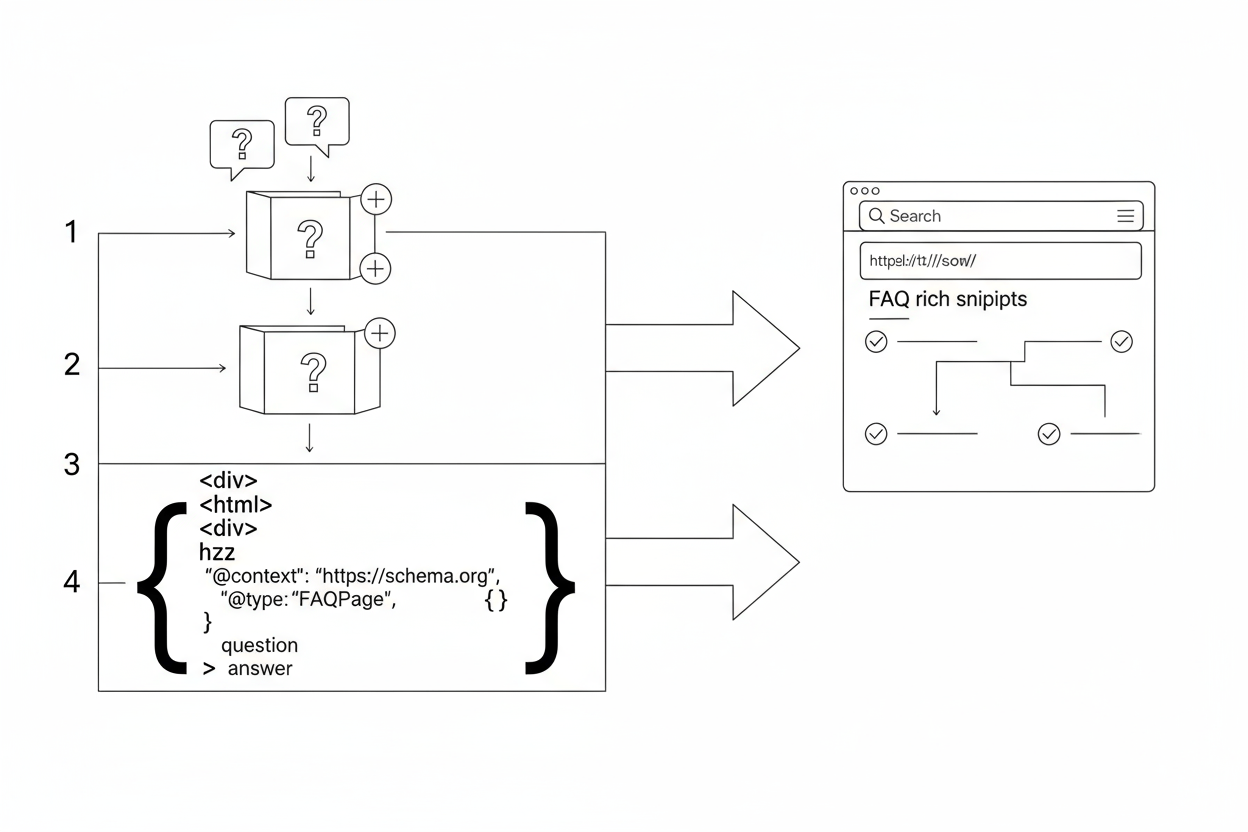You've seen them in Google search results: those handy drop-down accordions directly under a search listing, answering common questions related to the query. That valuable SERP real estate is often powered by FAQPage Schema Markup.
Implementing FAQ schema is one of the quickest and most impactful ways to enhance your search visibility, increase click-through rates (CTR), and directly answer user intent right on the results page.
As part of our deep dive into what Schema Markup is, this guide provides a practical, step-by-step workflow for correctly implementing FAQPage schema and validating it to ensure you're eligible for Google's rich results.
Why Bother with FAQ Schema? The Benefits
Implementing FAQ schema correctly offers significant advantages:
- Increased SERP Real Estate: The FAQ rich snippet takes up considerably more vertical space on the results page, pushing competitor results further down.
- Higher Click-Through Rate (CTR): By providing immediate answers and taking up more space, FAQ snippets naturally attract more clicks.
- Improved User Experience: Users can get answers to basic questions directly from the SERP, improving their perception of your brand's helpfulness.
- Potential Voice Search Visibility: Well-structured FAQs can sometimes be used by voice assistants to answer user queries.
Google's Strict Guidelines: Don't Get Penalized 🚨
Before you implement, you must understand and adhere to Google's specific content guidelines for FAQ pages. Violating these can lead to your rich results being removed or even a manual action penalty. Key rules include:
- Use Only for Genuine FAQs: The schema should only be used if the page contains a list of questions and their corresponding answers. Don't create fake FAQs just to get the snippet.
- Content Must Be Visible: The entire question and answer provided in the schema must be visible to the user on the page itself. Do not put content in the schema that users cannot see.
- No Advertising: FAQ content should be informational, not promotional. Do not use it for advertising purposes.
- Accurate Representation: Ensure the schema accurately reflects the content on the page.
For the full, official rules, always refer to Google's developer documentation for FAQPage Schema.
Understanding the Structure (Conceptually)
You don't need to write the code by hand (we'll cover generators next), but understanding the structure helps. FAQ schema uses a few key components defined by Schema.org:
- FAQPage: This is the main "Type" that tells Google the entire page represents a collection of FAQs.
- mainEntity: This property holds a list (an array) containing each individual question-answer pair.
- Question: Each item in the mainEntity list is a "Question" type. It has two essential properties:name: This holds the full text of the question itself.acceptedAnswer: This property holds the answer.
- Answer: Nested inside the acceptedAnswer property, this "Answer" type has one crucial property:text: This holds the full text of the answer. Importantly, Google allows simple HTML formatting within this text, such as links (), lists (, ), and paragraphs ().
The 4-Step Implementation Workflow (SOP)
Step 1: Identify or Create Suitable Content
Step 2: Generate the JSON-LD Schema
You don't need to write code. Use a reliable online generator:
- Merkle's Schema Markup Generator (FAQPage): A popular and easy-to-use tool where you simply type in your questions and answers, and it generates the correct JSON-LD script for you to copy.
- CMS Plugins/Features: Many platforms (like WordPress with plugins like Yoast or Rank Math) have built-in features to easily add FAQ blocks that automatically generate the necessary schema.
Step 3: Implement the Script
Step 4: Test and Validate (Absolutely Critical!)
Implementing broken schema is worse than implementing none at all. You must test:
- Use Google's Rich Results Test: Paste your URL (or code snippet). This tool will tell you if your page is eligible for the FAQ rich snippet and highlight any critical errors. This is the most important test.
- Use The Schema Markup Validator: Paste your URL. This tool checks if your schema syntax is technically correct according to Schema.org standards, even if Google doesn't use it for a rich result.
Fix any errors reported by these tools before expecting results. Our guide to Schema Validation & Testingcovers this in detail.
Common Mistakes to Avoid 🚫
- Hidden Content: Ensuring the Q&A in your schema exactly matches visible content on the page.
- Inappropriate Use: Using FAQ schema on a homepage or for promotional content.
- Single Question: FAQPage schema requires at least two question-answer pairs to be valid for Google's rich result.
- Syntax Errors: Forgetting commas or brackets in your JSON-LD (generators help prevent this).
Conclusion: A Quick Win with Big Impact
FAQPage schema is a relatively low-effort technical SEO task that can yield significant improvements in SERP visibility and user engagement. By following Google's guidelines carefully and validating your implementation, you can effectively capture valuable SERP real estate and provide immediate value to searchers.
Remember, FAQ is just one type. Explore other high-impact types like Product & Review Schemato further enhance your site's visibility.

